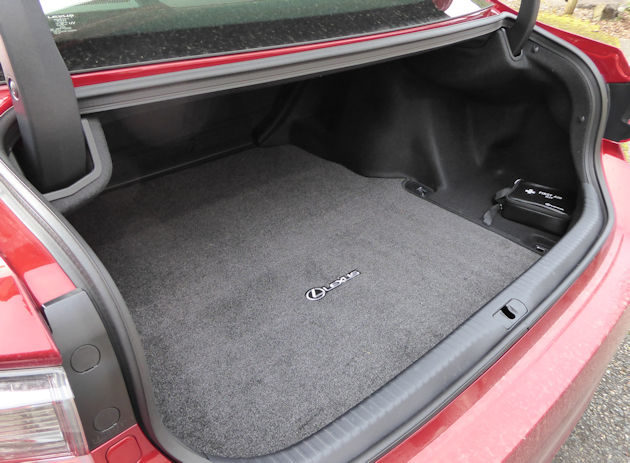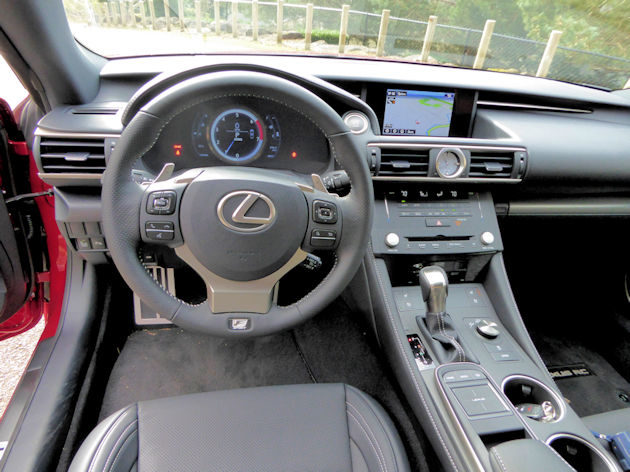By Barbara & Bill Schaffer
In the world of Lexus, the RC coupe is one of the lesser known and least popular models. Looking at the numbers, the RC has the second lowest sales for the brand lineup, right next to the elegant and expensive Lexus LS.
After spending a week driving the 2017 RC 200t recently, we can say with absolute certainty that there is nothing wrong with the mid-size couple, it?s outstanding. It?s just that the market for sporty coupes is limited. That also means the people who purchase an RC are getting a unique car that you won?t be seeing in every driveway.

The coupe category happens to be one of our favorite automotive groups, because we like the sexy appearance, the comfortable interior and many of the other features that set the RC apart from the sedans and SUVs. Besides we are the only two passengers in the car 99.9 percent of the time.

The Lexus RC fit our profile of what we would buy very nicely. The styling is outstanding, both inside and out, it has a variety of engine choices from a 2.0-liter turbo to a high performance V-8. All-wheel drive is available and it has all the features from our ?must have? list except for the Auto Hold feature that a few cars have. It holds the car?s brake on after the brakes are applied at a stop light allowing the driver to remove his/her foot until the light changes and the accelerator is pressed.

The Lexus RC styling is dramatic with its long nose fronted by the Lexus signature spindle grill. The roofline sweeps down to a short trunk which ends in subtle spoiler. The sides have a sculptured look that ends with an interesting faux air extractor at the rear corners. It looks fast, sporty and the styling turns many heads.

The interior is typical Lexus luxury, with plush deeply bolstered seats and a rich, quality look. The console and center stack are especially attractive and user friendly. Our test car did have the unique Lexus Remote Touch pad which controls navigation functions much like a touch pad on a laptop computer. It?s very user friendly but we found it to sometimes be too oversensitive, and took some getting used to. But overall, the cockpit is excellent.

The rear seat could handle two smaller adults or two children, but the adults would be cramped and it?s very difficult to access and exit from. The rear seat back does fold down in a 60/40 split to expand the 10.4 cubic foot trunk.

The RC is available in seven trims, if you count the F Sport models and V-8 powered RC F. The other models are powered by a 255-hp 3.5-liter V-6, a 306-hp 3.5-liter V-6 or a 241-hp turbocharged four-cylinder which was in our test car. All engines do require premium 91-octane fuel.

Like all the other models, our 2017 test Lexus RC Turbo with its turbocharged four-cylinder engine is a front-engine, rear-wheel drive configuration. It has an excellent eight-speed automatic transmission with Sport Direct Shift for manual shifting and steering wheel-mounted shift paddles. The RC 300 (with the 255-hp engine) has standard full-time all-wheel drive and the more powerful RC 350 is available in either rear- or all-wheel drive. All-wheel drive versions all have a six-speed electronically controlled automatic transmission.

The driver can choose a driving mode to adjust the RC to his or her driving style by selecting either Normal, Sport and Eco. Each mode changes the engine and transmission mapping along with the steering assist to fit the type of driving. The F-Sport models have a fourth setting: Sport S+ which also adjusts the handling performance of the Adaptive Variable Suspension and the available Dynamic Handling System.

Each Lexus RC is equipped with a sports car style suspension and a four-wheel independent suspension with double wishbones in the front and a multilink rear system. They all have large four-wheel ventilated disc brakes with all the latest electronic braking aids and Rack and Pinion Steering.
The RC Turbo accelerates from 0 to 60 in 7.3 seconds, while the V-6 versions take from 5.8- to 6.3 seconds. The Turbo has an EPA fuel economy rating of 22 mpg city, 32 mpg highway and 26 mpg combined. We averaged 27.1 mpg with mostly highway driving. Bill?s only complaint about the four-cylinder turbo engine was the turbo lag which we experienced when making quick passes. Barbara said, ?don?t pass then.?
The F Sport trim, which is available on the three base models (RC Turbo, RC 300 and RC 350) adds $4,105 to the Turbo model and similar amounts to the other two. It also includes an Adaptive Variable Suspension, various F Sport trim, heated and ventilated seats, power adjusting steering wheel, driver?s seat memory, perforated leather seating, heated steering wheel and at least a dozen other cosmetic and performance upgrades.

The 2017 Lexus pricing ranges from $41,130, including the destination charge, for the RC Turbo to $45,235 for the RC300 up to $49,850 for the AWD RC 350 F Sport. A fully loaded RC 350 F Sport has an MSRP of just over $54,000. The V-8 powered (467-hp) RC F has a base price of $65,140.
The Lexus RC handles like a sports car, cornering flat, going exactly where it?s pointed and stopping quickly when needed. It?s a fun car to drive and fits nearly all our requirements for a new car. The only downside we found was that because it is essentially a sports car, it?s low and harder to get in and out of ? unfortunately, that?s something we need to think of as we age.








